A writer explores the artistic side of Adelaide
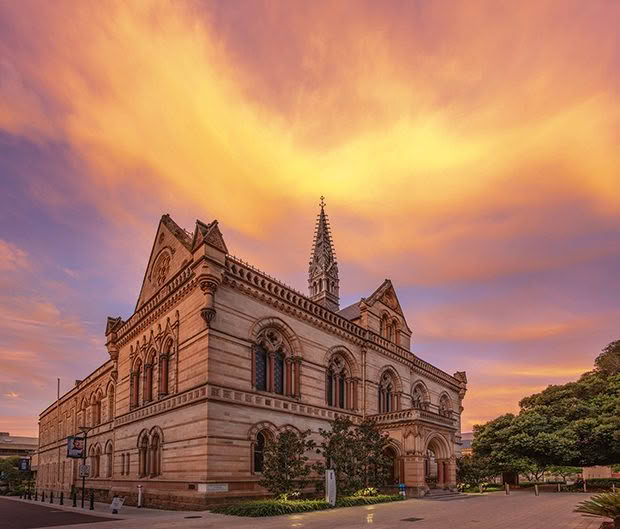
The Mitchell Building at the University of Adelaide is on North Terrace, which runs down towards the Botanic Gardens past many examples of heritage architecture. (Photo: Michael Waterhouse)
A stroll through the streets and galleries of Adelaide inspires a new way of seeing.
Words: Chris van Ryn
I skip down the steps of the Art Gallery of South Australia (AGSA) onto Adelaide’s tree-lined North Terrace, a sweeping boulevard of colonial buildings made from the quintessential sand-coloured tuff, a volcanic stone hewn into shape by convicts in Australia’s quarries. I had not set out to find a new way of “seeing” when I arrived in the self-proclaimed City of Art. But now I feel a growing excitement. I’ve experienced a buffet of local and international artworks, and something in me has changed.
Many send my mind spinning: two full-size mannequins studded with hundreds of nails; a room of mirrors reflecting an infinite number of golden pumpkins; an arrangement of marble plinths, each engraved with despairing text messages sent by unidentified Manus and Nauru Island refugees.
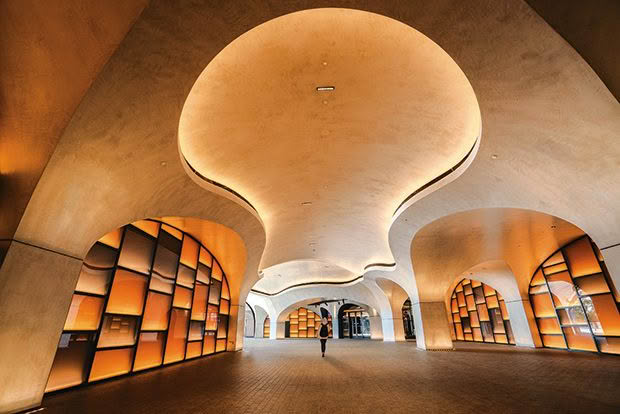
With overground modern tram systems and underground connections, Adelaide has an effective public transport system, in part thanks to Colonel Light and his initial town planning.
One room is filled with 180 kilometres of blood-red wool, strung like a spider’s web from the ceiling and walls. The threads are anchored to the floor with prosthetics: pale, amputated arms with claw-like hands. And one artwork is more challenging than the rest: a sculpture in the centre of the Melrose Gallery. It is so confounding; I park it in a corner of my mind and head outside.
On the black granite edge of a water feature, I sit and contemplate a reflection of the gallery, its Doric columns and portico roof rippling gently. I feel intoxicated; the atmosphere tingles with possibility, a nearby subtropical jacaranda with its violet-coloured flowers is inflamed with vibrancy.
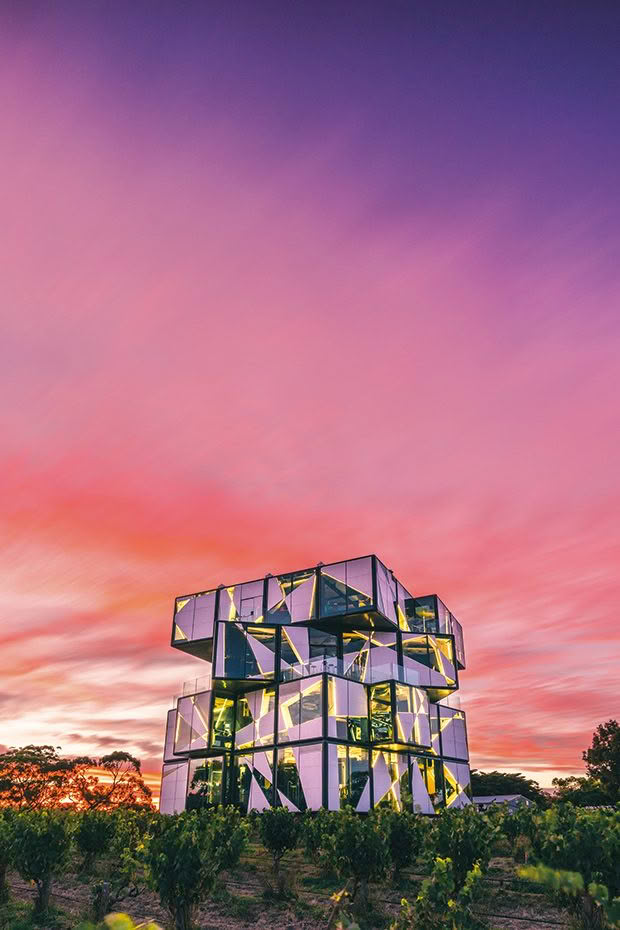
The d’Arenburg Cube is about one hour by car from the city centre, located on the vineyard that produces the Red Stripe label. Designed around Rubik’s Cube, it houses an eclectic art collection and a restaurant.
Inspired, I sit next to the water on North Terrace and write about Light’s Vision.
It is 1837. Fifty-one-year-old Colonel William Light stands at an angled table, studying a map, ink pen and straightedge to hand. It depicts a gently undulating geography. There are pearl-white sandy beaches where the waters of the Indian Ocean lap, and marshes merge into bushlands rich with eucalyptus.
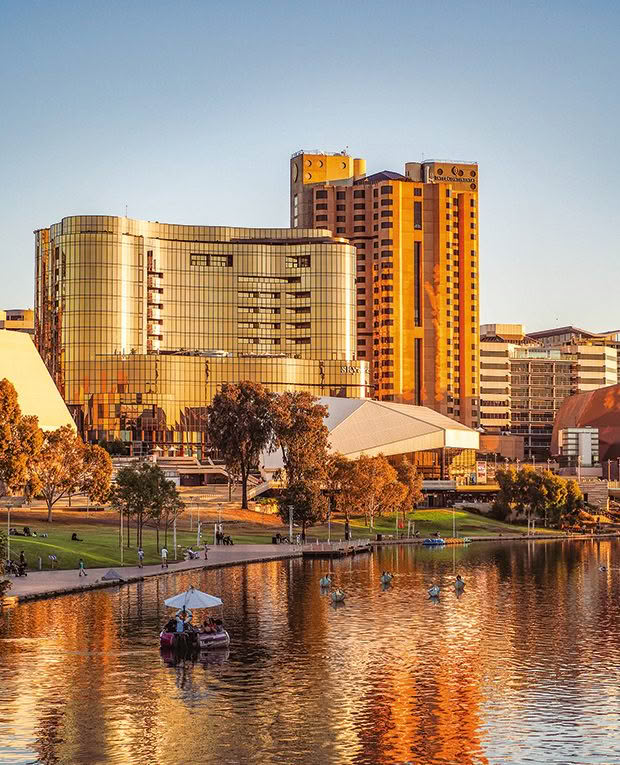
Light reflected on building facades viewed from the Adelaide Riverbank Pedestrian Bridge, which sweeps from the Dunstan Playhouse and Adelaide Oval across the Torrens River.
The landscape is interspersed with a network of unresisting trails, pressed hard by the wide, calloused feet of indigenous nomads. There’s a snaking river, clear and pure, called Karrawirra Parri (later renamed the Torrens) — critical drinking water. And there are the words: Adelaide Plains.
With ink-smudged fingers, Light slides a transparent sheet over the top of the cartographer’s survey and draws a grid of wide, ruler-straight, multi-lane roads, six city squares and 1042 one-acre lots, spaces for new colonial-style buildings. With meticulous care, he scribes the words: Adelaide City.
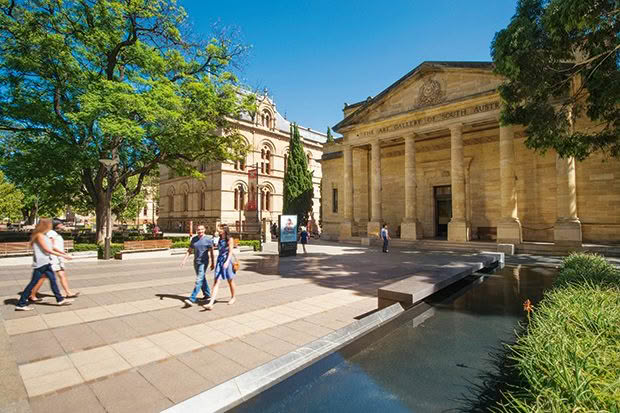
Each hall in the Art Gallery of South Australia contains an arrangement of art across centuries curated not by period but by themes.
It’s a landscape transformed, a finely calibrated geometry shaped by a man with a compass and divider, superimposed onto a landform shaped by nature and time.
And then Colonel Light does something known as “Light’s vision”. Surrounding the city, he draws a large green belt. It becomes home to parklands and, 20 years later, the Botanic Gardens. Nature is a tonic for body and mind, Light muses.
I reach a wide concrete path that bisects part of the 51-hectare Botanic Gardens. There is a symphony of sounds. Aromas drift in from unfamiliar blossoms. There’s a hum of pollinating insects. The air rustles.
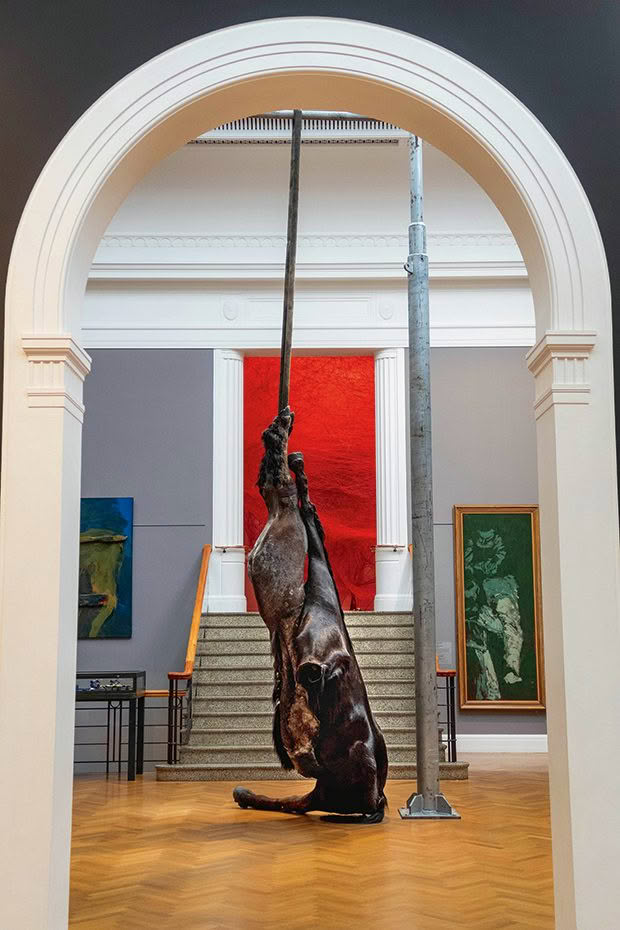
We are all Flesh is the title of this somewhat-confronting sculpture featured in the centre of the Melrose Gallery at the AGSA. The gallery has a diverse and eclectic collection of art sure to challenge perspectives.
The gardens are filled with exotics: norfolk island pine, hoop pine, new caledonia pine, bunya pine, the monkey puzzle, camphor, sweet bursaria and red cedar. Pines emit phytoncides, a natural anti-inflammatory and antibacterial, which percolate through my nostrils alongside the sweet scent of resinous sap.
There’s a small path fringed by bamboo trunks so tall and slender their tops lean towards the middle, so it seems I’m passing through a tunnel and a slice of Japan. I linger in the shade before exiting onto a large open lawn, at the end of which stands the Museum of Economic Botany.
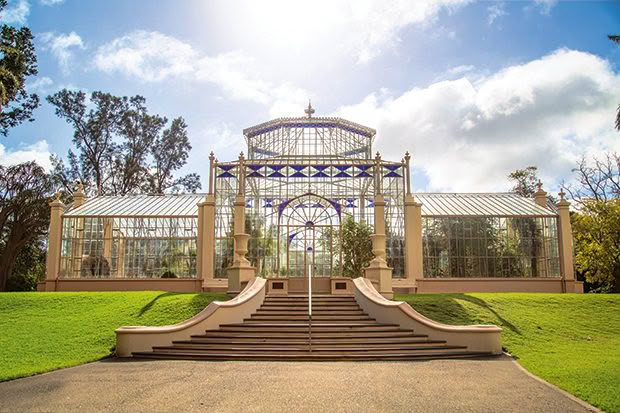
Palm House, Adelaide Botanic Garden; the gardens ringing the city centre are one of Adelaide’s standout features.
The interior is bathed in old-fashioned charm. Two tables display dried flowers and scraps of bark and herbs and spices. There are seeds as small as rice and one bifurcated seed so enormous it resembles hairy human buttocks. There’s a cluster of peppercorns and a bell-shaped seed with needles that curve like a swan’s neck and oval leaves, each with a delicate web of veins and a sensual dip at the end. Some seeds seem fragile but are steel-strong; others are embroidered with silk-like wind-catching threads.
Each item has a short description: for women suffering a miscarriage, for Egyptian mummification, used as herbal medicine and rodent poison, used in the textile industry as a natural comb, used to make elderberry wine, used after childbirth, a natural laxative, and so on.
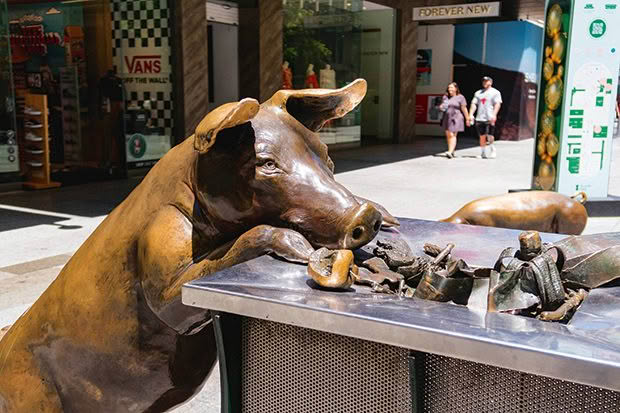
Rundle Mall, which runs parallel to North Terrace, has a range of whimsical sculptures that add to the atmosphere of the city of art.
Zooming the lens way out, I see art sculpted by evolution, where form and function harmonise without compromise. I see the origins of agriculture, that fulcrum in human evolution catapulting us from 250,000 years of hunter-gatherers to modern humans and economies. I see the natural pharmaceuticals used by Australia’s indigenous peoples and the journey to modern drugs. Later, I saw this moment as a catalyst in my journey towards culinary medicine, a move that will change my life.
The wheels of our rickshaw bump over a kerb onto the cycleway. Louis, my guide, grips the handlebars. I’m reminded of Calcutta, except 20-something, mural-obsessed Louis is neither bare-footed nor dhoti-wearing, and an electric motor adds power to his push.
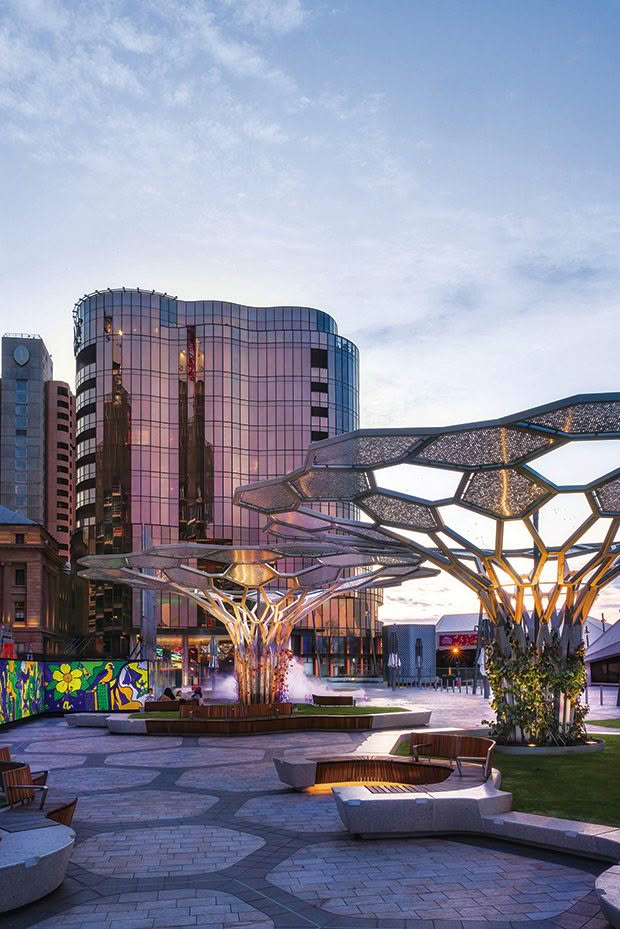
Festival Plaza is a vibrant destination with people-focused spaces in which to congregate, relax, shop and dine.
In search of wall art, we dart in and out of the alleyways that thread through inner-city industry and quaint, high-density, residential neighbourhoods sprinkled with public sculptures, cafês and bonhomie. Adelaide has about 110 murals. And in the spirit of Banksy, these bold and colourful murals often depict social and political issues.
Lewis swings the rickshaw into Vardon Street. We’ve discovered one of Irish muralist Fin Dac’s Hidden Beauties series. Covering the front of a small building is a meticulously rendered artwork, depicting a large, fine-boned Eurasian woman with a high bouffant hairdo and a disconcerting smear of blood red on her lips. From the sides of her head dangle two long pieces of jewellery. Then I see the “jewels” are the building’s windows, which glow at night: the architecture has informed the mural.
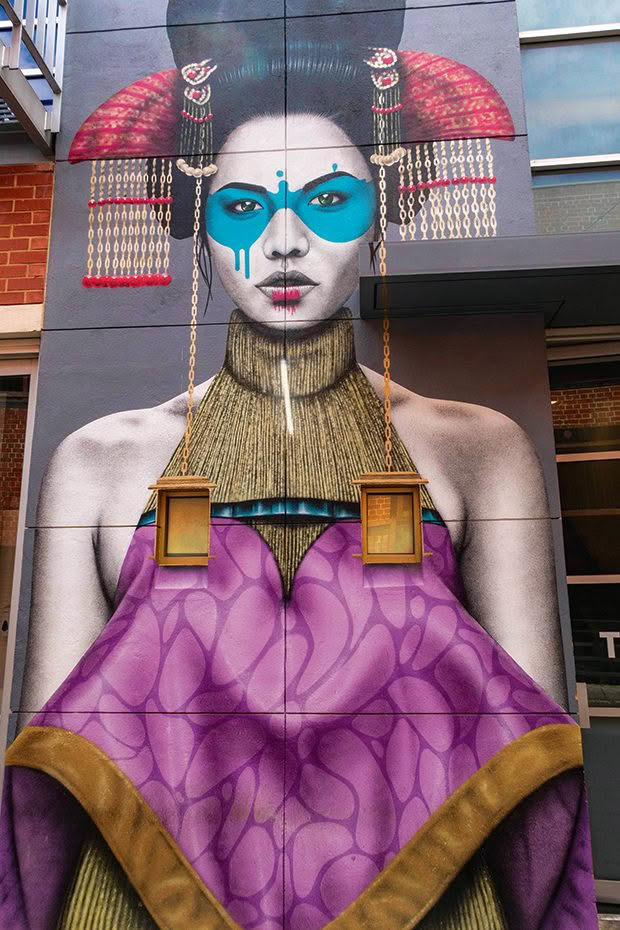
Fin Dac’s mural Zaluuokhin in Vardon Street took three days to complete and is part of the artist’s Hidden Beauties series, portraits of Eurasian women that can be seen across the globe (including Hidden Beauty in Christchurch).
In the evening, I walk along the banks of the coffee-coloured Torrens, that once vital “highway” for a fledgling Adelaide, now Australia’s fifth most-populated city, with 1.3 million residents. Cyclists, runners and strollers pass me by. An energetic poodle pulls along an elderly couple. I keep pace with the sluggish water, lost in reverie.
During my time in Adelaide, I stumbled across different ways of “seeing”: botany not just as seeds and husks, herbs and spices, but shapers of economies, pharmaceuticals and society — and through a sculptor’s eyes, artworks of evolutionary beauty. And the city’s murals, commenting on society, shaped by the architecture, unconstrained by art-speak, art investors or patron’s purchases. And Light’s vision: greenery shaping our minds and moods, influencing how we see the world. And the art in AGSA, forging new creative neural networks, bumping me out of complacency. Wham! There’s a click in my brain. AGSA. I stare at the Torrens. Is that what it’s all about? A reel of the encounter in the Melrose Gallery begins to roll…
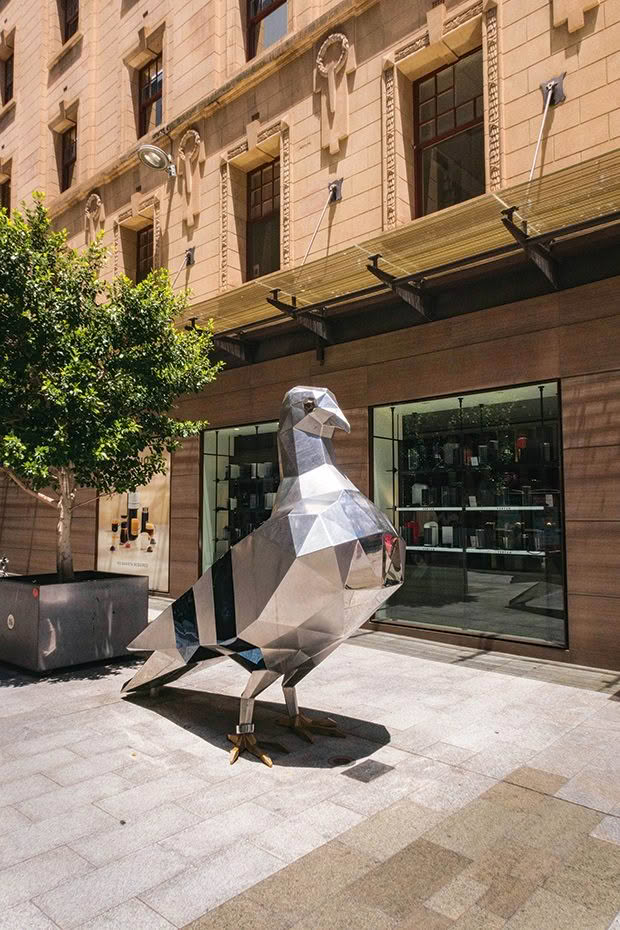
“What do you think?” I ask a young man as we circumnavigate the corpses. His bicep tattoo — a snake — slithers as he holds his chin between thumb and forefinger. Two headless horse carcasses, woven into one, hang from a towering, galvanised steel gantry. These once-were-beasts with their once-pulsing flanks are now embalmed corpses — and “art”.
I avoid one horse’s hind legs, which drape over the parquet, scarred and scuffed by the shoes of 270,000 annual gallery visitors, and look at the young man expectantly.
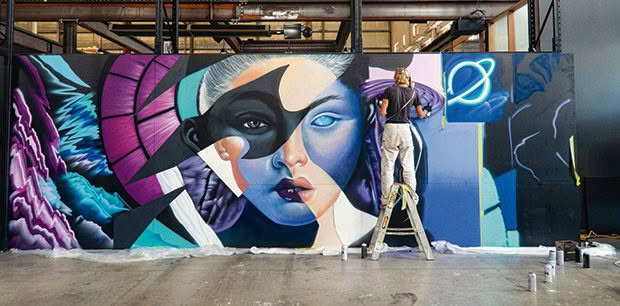
Initially established to discourage graffiti each year, the Fringe Street Art Explosion programme commissions Australia’s best emerging and established artists to create large-scale murals across the city.
The snake shrugs emphatically, and he says: “What’s to think?”
I nod. Indeed. “Perhaps it’s something you feel?”
And I do. I feel both horror and a deep sense of awe. The horse carcasses entitled We Are All Flesh is art that spans the entire emotional experience. Life is made possible – and beautiful — by the inevitability and acceptance of death. I cannot control death, but I can control how I see the world.
Damn. All this life-enhancing wisdom in an un-beautiful beautiful sculpture. And right now, this minute… I’m alive. I feel a rush of gratitude.
Back at the Mayfair Hotel, I sip whisky, my skin glowing from the heat of a shower. I reach for my journal and write, “Have an adventure every day.”
You may not get another.
NOTEBOOK
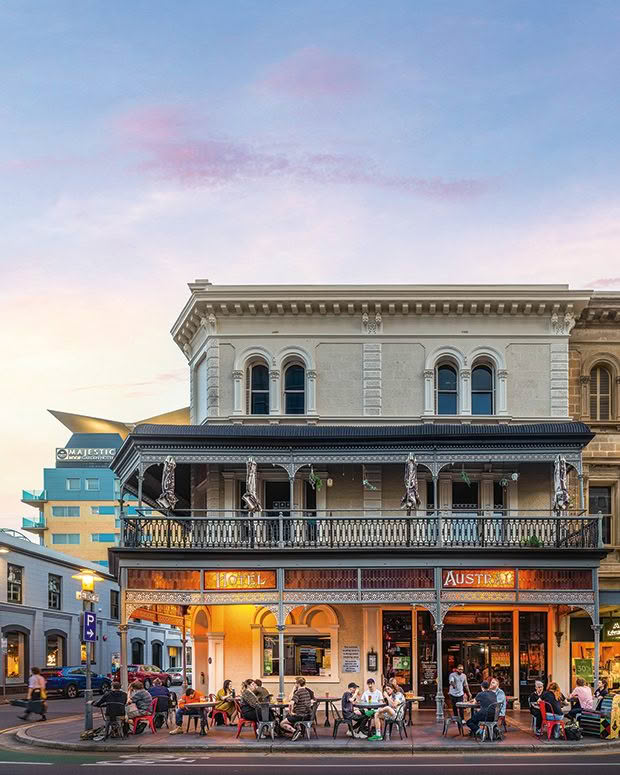
● AGSA, on North Terrace, is home to 45,000 artworks. Its superb and innovative curating makes it a must-see. agsa.sa.gov.au
● 2KW is a great place for dinner. Have an adventure: hand your menu selection over to the waiter. 2kwbar.com.au
● Breakfast at Crack Kitchen or Grandma Ben — or both. Innovative menus with great coffee. crackkitchen.com.au/mygrandmaben.com
● Visit d’Arenberg vineyard and the Cube for an otherworldly experience of eccentric artwork, great wine and a fabulous restaurant meal. You’ll need to hire a car to get there, but it’s worth it. darenberg.com.au
● Stay at the Mayfair Hotel. It’s a part-heritage building, part-modern addition located on King William Street, right in the centre of town. mayfairhotel.com.au
● Take a food tour of the central city markets. The variety of foods is staggering, and each stall has a story. ausfoodtours.com
Love this story? Subscribe now!
 This article first appeared in NZ Life & Leisure Magazine.
This article first appeared in NZ Life & Leisure Magazine.
